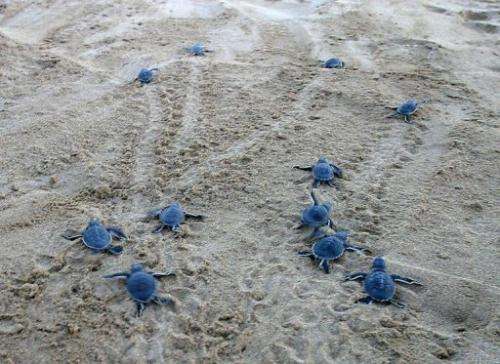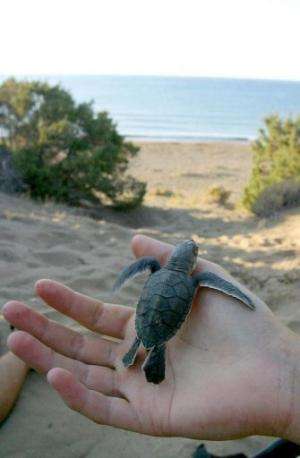Cyprus offers safe haven for turtles across divide

On a late August evening, thousands of baby endangered sea turtles flip, flop and somersault down the sands of this protected beach in northern Cyprus as excited onlookers cheer them on.
"Go on little turtle! A couple of inches and there you go!" yells Elliott Evlyn-Bufton, a 12-year-old Briton whose family came to the holiday island to watch the green turtles and loggerheads hatching.
Hundreds of sea turtles hatch each summer on the island's beaches, both in the Turkish north and the internationally-recognised south, to the delight of environmentalists and tourists alike.
The success story is shared, but for different reasons on an island that was divided by a 1974 invasion of its northern third by Turkish mainland troops.
Elliott brought baby turtles to the sea with the Society for Protection of Turtles (SPOT), a turtle conservation project on Alagadi beach near the picturesque harbour town of Kyrenia in northern Cyprus.
The tiny hatchlings, once placed on the beach, frantically flap their flippers to reach the sea. They had been rescued that afternoon from their shallow nest in the sand.
"Only one hatchling in a thousand makes it until adulthood, that's why we try and increase their survival rate as much as possible," said Sara Toule, an Aberdeen biology graduate who helps SPOT.
Not all the babies had the same strength. Some set out energetically for the Mediterranean sea, others lay motionless until the waves snatched them away.

At night, baby turtles know their way thanks to the moon's reflection on the sea. When there is no moon, they are guided by the torch of a volunteer standing waist-deep in the sea.
Cyprus is home to more than 30 percent of the Mediterranean's loggerhead (caretta caretta) nests and more than 20 percent of those of green turtles (chelonia mydas), according to figures provided by environmentalists on the two sides of the island.
Both species are endangered, the International Union for Conservation of Nature says, mainly due to intensive fishing.
After a mother turtle lays its eggs, metal grids are placed over the nests to prevent scavenging from foxes and other creatures.
"If we don't protect them, 60 percent of the eggs will get eaten," says Chelsea Crossingham, an English university student and SPOT volunteer.
"Since 2006, there has been an explosion in the number of turtles' hatchlings in the protected areas. Only in Cyprus, in all the Mediterranean area, has there been such an increase," said Andreas Demetropoulos, who along with Myroula Hadjichristophorou is in charge of turtle conservation in southern Cyprus.
"The number of turtles' nests on our beaches is very high. This shows that our efforts, since the 1990s, have paid off," said Hasibe Kuset-Oglu, their counterpart on the other side of the island.
"The most difficult thing has been to persuade politicians to ban tourism construction," she said.
"Some people want to get rich fast and have pressured the politicians. Now it's better. We are also expecting a grant from an EU project that aims to protect all the species on our coasts."
"Paradoxically, our advantage, here in north Cyprus, is that we have less money than in the other part, so we attract fewer property developers," explained Kuset-Oglu.
On both sides of the island, environmentalists have tried to combat heavy construction and mass tourism, which pose a threat to nests and mislead new hatchlings with lights that lure them away from the sea.
"Greece, Turkey and Cyprus are massive tourism destinations for Europeans. And turtles nest mainly on these beaches," said Robin Snape, a SPOT member and researcher from Exeter University in southwest England.
In the relatively affluent south, turtles have been legally protected since 1971, Demetropoulos said, and fishing and tourism development are regulated. In the north, conservation started later and depends on research projects like SPOT.
Demetropoulos underlined the importance of protecting nesting beaches. Turtles return to nest on the beaches where they were born, 20 or even 40 years later, "mainly thanks to geomagnetic forces," he said.
(c) 2012 AFP

















